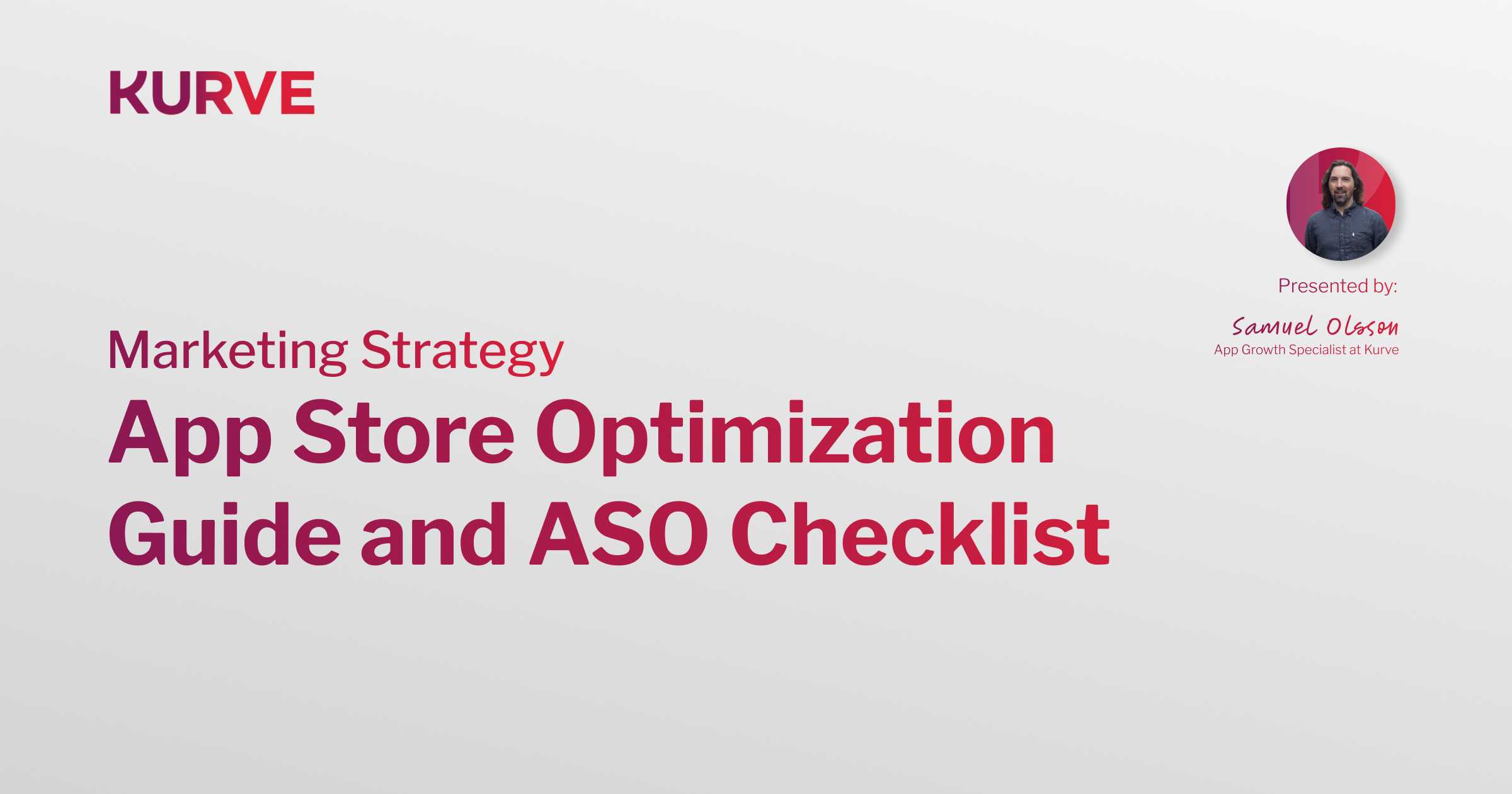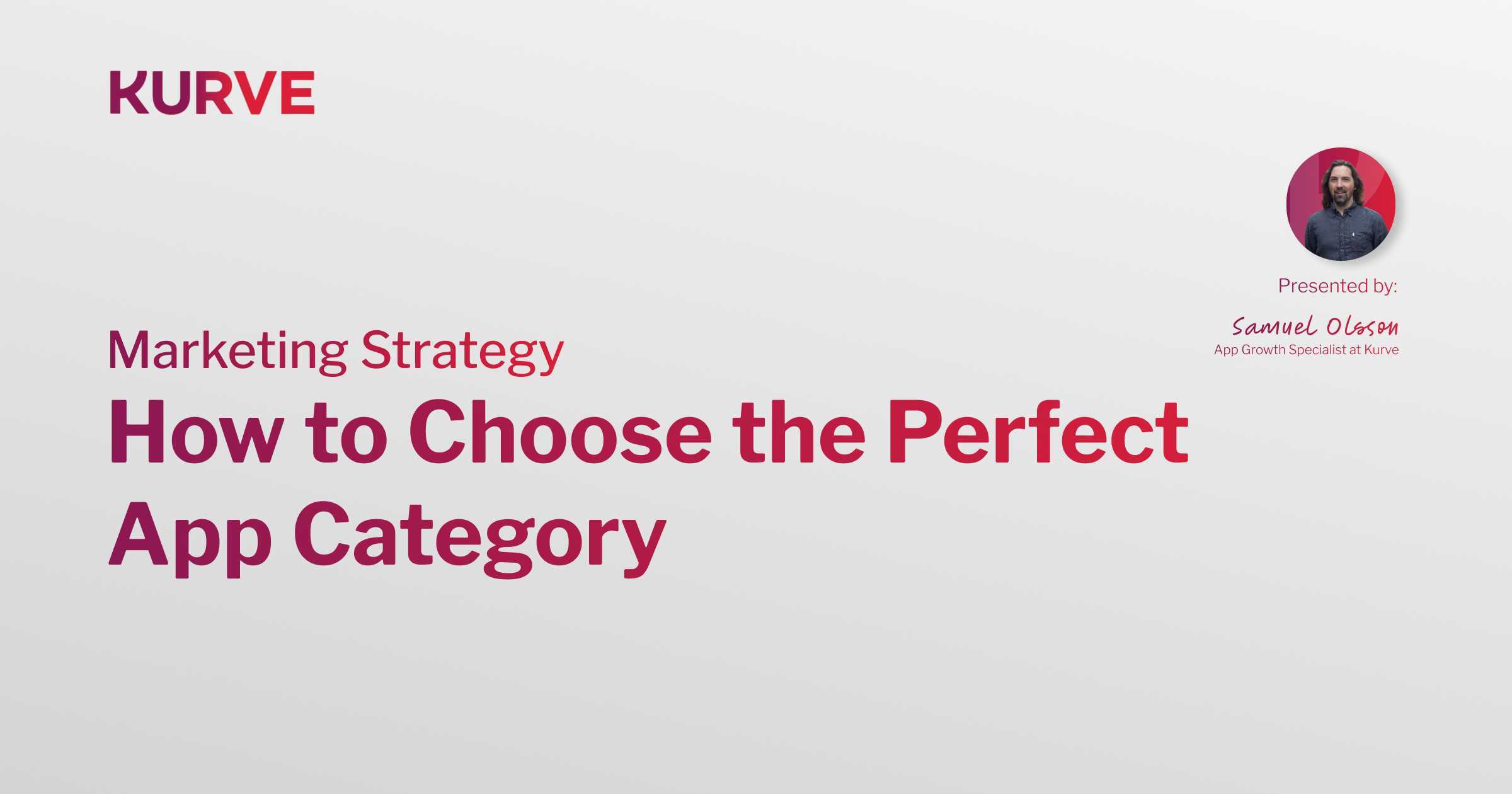Sleek, Stimulate, Strategize: Powerful Practices for App Engagement
In the competitive mobile app market, attracting and keeping users engaged with your app is more important than ever. App engagement is the key to retaining users and achieving long-term success, ensuring your app stands out.
This guide will cover everything you need about mobile app engagement. It discusses its significance, crucial metrics, and proven strategies to enhance engagement levels. You will be equipped with the knowledge to develop an app engagement plan that helps your mobile app flourish in the competitive arena.
At Kurve, we offer Mobile App marketing services for those seeking expert support. We're ready to assist you in your app engagement journey.
What is Mobile App Engagement?
Mobile app engagement refers to the quality and frequency of user interactions with a mobile application after downloading and installing it.
It encompasses various activities; opening the app, interacting with its features, making in-app purchases and sharing the app with others. App engagement metrics, such as session length, frequency of use and retention rate, help determine how effectively an app meets users' needs and expectations.
A high level of app engagement signifies that users find the app valuable and are likelier to remain loyal, make purchases, and promote it to their networks. In contrast, low concentration can result in uninstalls and missed revenue opportunities.
Optimizing app engagement is crucial for achieving long-term success and growth in the competitive mobile app market.
Why is App Engagement Important?
App engagement is vital in mobile app marketing for several reasons.
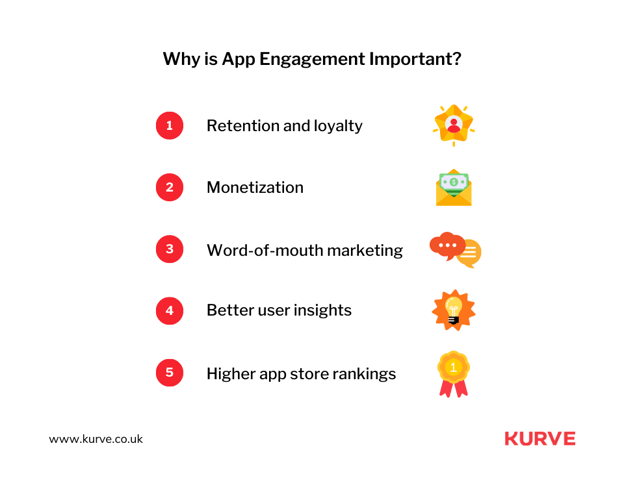
- Retention and loyalty: Engaged users are likely to continue using the app, reducing churn and increasing customer lifetime value.
- Monetization: Users who actively engage with an app are more likely to make in-app purchases, subscribe to premium features, or click on ads, generating revenue for the app.
- Word-of-mouth marketing: Satisfied, engaged users are likely to recommend the app to friends and family, amplifying your user acquisition efforts.
- Better user insights: Monitoring app engagement metrics helps you understand user behavior, preferences, and pain points. This enables you to make informed decisions about app improvements and marketing campaigns.
- Higher app store rankings: App stores like Google Play and Apple's App Store consider user engagement when determining app rankings. Higher engagement can improve your app's visibility and discoverability.
Focusing on app engagement drives long-term success and growth for your mobile app in a highly competitive market.
App Engagement Metrics
App engagement metrics are quantifiable data points that help evaluate the effectiveness of a mobile app in attracting and retaining users. These metrics provide insights into user behavior, preferences, and interaction patterns. This insight enables app developers and marketers to make informed decisions for app improvements and marketing strategies.
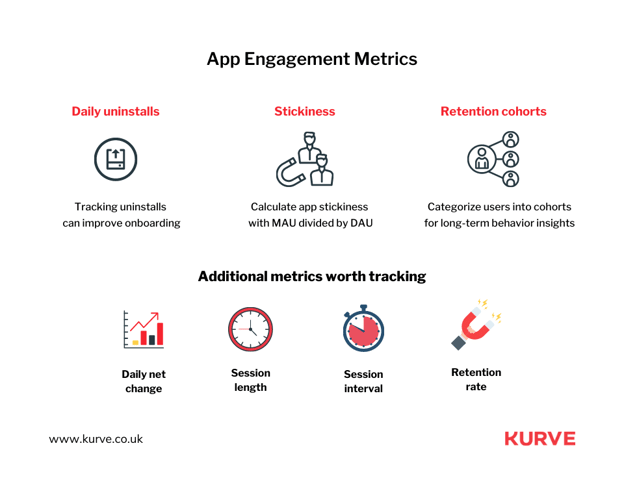
This section will explore essential app engagement metrics to help you better understand and optimize your mobile app's performance.
Sessions: Length and Interval
Session length refers to a user's time within the app during a single visit. Session interval represents the time between consecutive app sessions. Both metrics offer valuable insights into user engagement patterns.
A longer session length suggests users find the app content or features valuable. Shorter session intervals can indicate frequent app usage. Monitoring these metrics can help identify areas for improvement, such as enhancing app features or optimizing the user experience to encourage longer and more frequent app usage.
Screen Views
Screen views, also known as page views or screen impressions, measure the number of times users view a specific screen or page within the app. This metric helps assess the popularity and effectiveness of different app sections or features.
A high number of screen views indicates that users find a particular screen engaging. A low number suggests that the screen may need improvement or better promotion. Analyzing screen views can help you identify which parts of your app are most engaging and prioritize improvements based on user behavior.
Active Users
Active users are the number of unique users interacting with your app over a given period. There are several measures; daily active users (DAU), weekly active users (WAU), and monthly active users (MAU). This metric helps evaluate the app's user base and growth potential.
A high number of active users signifies a healthy, engaged audience. Conversely, a low active user count may indicate user acquisition or retention issues. Monitoring active users can help you identify trends, set benchmarks, and develop targeted marketing strategies to grow and maintain your user base.
Retention Rate
The retention rate measures the percentage of users who return to the app after their initial visit. It's a crucial metric for understanding user satisfaction and loyalty.
A high retention rate indicates that users find your app valuable and are more likely to continue using it. In contrast, a low retention rate suggests users are losing interest or facing challenges within the app.
You can identify user experience issues by analyzing retention rate data, optimizing app features, and developing targeted re-engagement campaigns to improve user retention and loyalty.
Daily Uninstalls/Churn
Daily uninstalls, or churn rate is the percentage of users who uninstall your app within a specific period. It's typically measured daily. This metric helps assess user dissatisfaction and potential issues within the app.
A high uninstall rate may indicate problems with app performance, usability, or feature set. Whereas a low uninstall rate suggests user satisfaction and continued engagement. Monitoring daily can help you identify and address factors driving users away, improving user retention and app success.
App Stickiness
App stickiness is the ratio of daily active users (DAU) to monthly active users (MAU).
A high stickiness ratio indicates that users frequently return to the app, suggesting strong user engagement and satisfaction. In contrast, a low stickiness ratio may signal issues with user retention or app features.
Monitoring app stickiness can help you identify opportunities to enhance user experience. Improving a user's experience can encourage repeat usage, driving long-term app success.
Loyal Users
Loyal users demonstrate high engagement and commitment to your app, using its features, making in-app purchases, and recommending the app to others. These users often have a higher lifetime value and contribute significantly to your app's growth and success.
Identifying and nurturing loyal users can help you optimize your app's user experience, tailor marketing efforts, and enhance retention strategies. By focusing on loyal users' preferences and behaviors, you can create targeted campaigns and features that cater to their needs, boosting user satisfaction and app performance.
What are the key types of automation apps businesses can leverage?
Enhancing mobile app engagement is crucial for businesses, and automation is vital in maintaining user interest at every user journey stage.
There are three main types of automation: transactional, lifecycle, and campaign automation.
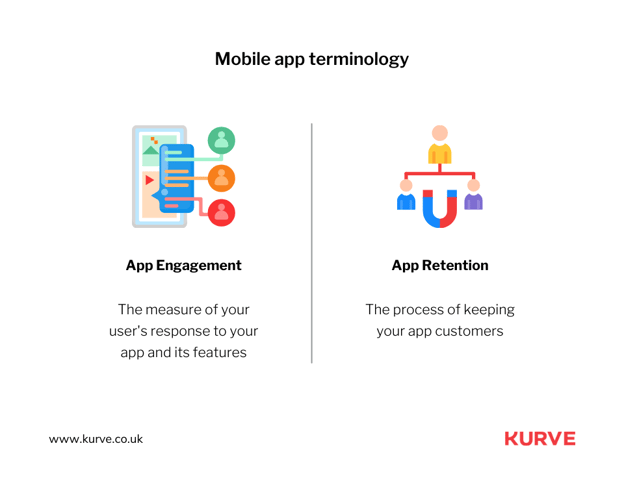
Let's explore each type in greater detail to understand better how they contribute to your app's growth and user retention.
Transactional Automation
Transactional automation involves engagements triggered by specific events within your app. An example is sending a welcome email upon user registration or a password reset email. This type of automation ensures seamless communication with users, reinforces trust, and helps them better understand your app's functionality.
Implementing transactional automation reduces friction and improves user satisfaction, creating a smoother experience for users as they interact with your app.
Lifecycle Automation
Lifecycle automation guides users through your app journey by sending targeted content based on their behavior and preferences. This tailored approach enables personalized experiences that cater to individual needs, such as nurturing campaigns for at-risk users or rewards for loyal customers.
Understanding user behavior and employing effective lifecycle automation can foster long-term relationships and increase user retention. Monitoring and updating your lifecycle automation strategy ensures its effectiveness in nurturing users at various stages of their app journey.
Campaign-related Automation
Campaign automation pertains to one-off campaigns sent to users to inform them about relevant news or updates. An example could be holiday promotions for an e-commerce store or new updates for a gaming app. These campaigns create excitement around new features, offers, or promotions, encouraging users to re-engage with your app.
By leveraging campaign automation, you can maintain user interest and drive engagement with your app's latest offerings. Timely and targeted campaigns help boost user loyalty and satisfaction while providing valuable insights for future marketing efforts.
How your approach to automation changes as your company grows
As your startup evolves, your approach to automation must adapt to meet changing needs.
Complex or expensive automation tools aren't necessary when you've just launched your app and have yet to achieve product-market fit. However, basic activation flows are essential, so consider free or low-cost tools to encourage sign-ups and maintain engagement.
Upon reaching product-market fit and experiencing an influx of new users, you must expand your automation flows. Access to more data will be crucial for decision-making and enhancing app engagement throughout the user lifecycle.
As you scale up, advanced automation becomes imperative. With vast data, you can develop intricate automation flows based on user insights. You can identify potential churn, recognize pivotal engagement moments, and establish an effective referral system with proven incentives.
Using automation to improve your pirate metrics (AARRR)
"Pirate metrics" or "AARRR" is a standard method for assessing marketing and growth performance, consisting of:
- Acquisition
- Activation
- Retention
- Referral
- Revenue
.png?width=624&height=488&name=Using%20automation%20to%20improve%20your%20pirate%20metrics%20(AARRR).png)
Automation's primary benefits occur post-acquisition.
Here's how automation can influence your (A)ARRR.
- Improving app activation with automation
Users often download multiple apps before committing to one, making your activation sequence crucial. This sets the tone for the user journey and future engagement. Early-stage automation efforts aim to connect with customers, demonstrate future expectations, and prevent app abandonment. High initial engagement increases the likelihood of sustained attention throughout the user lifecycle.
- Improving retention with external triggers
Automation influences whether apps become essential daily tools or fade into obscurity. By identifying signals and behaviors that lead to active engagement, you can optimize automation flows to engage new users. For example, push notifications can encourage users to maintain a consistent usage streak, leading to habitual engagement. Custom churn flows, such as emails and push notifications, can be sent to users who last opened the app several days ago.
- Using automation to increase your referral rate
Referrals are often overlooked but remain vital in today's market. Gathering reviews is a quick and effective way to improve referral rates. Incentivize reviews with well-timed push notifications. Be sure to target users who show enjoyment in your app. Additionally, develop a referral system that suits your business. For example, offer incentives for gaming app users to invite friends or e-commerce app users to provide discount codes for referrals.
- Making the most of new revenue opportunities
Revenue automation is essential for any engagement strategy, even in the early stages. Maximize revenue by sending one-off emails for sales, prompting users to sign up for paid accounts, or notifying customers of new items in stock. Easy-to-set-up flows in CRM or app engagement platforms can deliver results when campaigns align with customer expectations.
Best Practices for Increasing App Engagement
Increasing app engagement can be challenging, especially with the ever-evolving mobile app market. One way to overcome these challenges is to learn from successful examples like Sweatcoin, which became history's fastest-growing health and fitness app.
Our partnership with Sweatcoin played a crucial role in boosting engagement and driving growth (learn more about Sweatcoin's success story).
This guide will explore tips, strategies, and best practices to increase app engagement based on available research and industry insights. These practices can help you build a strong user engagement and retention foundation, from optimizing your app's onboarding process to employing effective app marketing strategies.
Sleek: App Onboarding Process
A well-designed app onboarding process is crucial for creating a positive user experience. It is the first interaction users have with your app, and it helps them understand its value proposition and how it works.
A sleek and frictionless onboarding process can improve user engagement and retention by making users feel comfortable, informed, and motivated to explore your app further.
Earn Trust First
Building trust with your users should be a priority during the onboarding process. Start by being transparent about your app's purpose, data usage, and privacy policies. You can also showcase user reviews, ratings, or testimonials to establish credibility. By earning their trust, you can ensure users are more likely to engage with your app and share their personal information when required.
More straightforward Sign-up/Account Registration
Lowering friction during registration can improve conversion rates and increase user engagement. To achieve this, reduce the number of input fields, offer social media login options, and avoid forcing users to create an account unless necessary. Instead, where possible, use a simple sign-up or account registration process.
Personalized Welcome Page/In-App Message
Personalization helps users feel valued and engaged, leading to higher retention rates and a more enjoyable user experience. For example, you could create a personalized welcome page or in-app message that addresses users by name. Or, you could showcase content tailored to their preferences or interests.
Custom Avatars
Allow users to create custom avatars to add a personal touch to their in-app experience. Custom avatars make users feel more connected to the app and foster a sense of ownership and belonging, increasing engagement and loyalty.
Offer Self-Service Content
Provide users with easy access to self-service content like FAQs, video tutorials, and help articles. This empowers users to learn about your app and troubleshoot issues independently, reducing frustration and increasing user satisfaction.
Allow Skipping Tutorial
While tutorials can be helpful, not all users may need or want them. Offer the option to skip the tutorial for those who prefer to dive straight into your app. This flexibility caters to different learning styles and ensures that users can engage with your app in the way that suits them best.
Stimulate: User Engagement
Continually stimulating users through interactive and dynamic features is essential to maintain user interest and increase app engagement.
By incorporating social elements, gamification, user competitions, and offering excellent customer support, you can create an environment that keeps users entertained, motivated, and connected to your app.
Additionally, implementing well-crafted push notifications can effectively drive user engagement and retention.
In-app Social Features
Integrating social features into your app can foster community and encourage interaction. For example, features like chat rooms, social media sharing, and friend referrals can create an environment where users feel connected to others and are more likely to engage with your app.
App Gamification
Gamification involves incorporating game-like elements like points, levels, and rewards into your app. By making the user experience more fun and rewarding, you can increase user engagement, motivate them to complete tasks and enhance user satisfaction and loyalty.
Customer Support
Providing excellent customer support is essential for user engagement. Users who experience issues or have questions about your app need prompt and helpful assistance. By offering in-app support, such as live chat or a help center, you can quickly address user concerns and ensure they have a positive experience, increasing the likelihood of continued engagement.
App User Competition
Introducing friendly competitions within your app can motivate users to engage more frequently and for extended periods. Leaderboards, challenges, and contests can foster a sense of achievement and friendly rivalry, encouraging users to return to the app and compete with others.
Adequate Push Notifications
Push notifications can be an effective tool for driving user engagement when used thoughtfully. Craft relevant and timely notifications that inform users about new features, special offers, or personalized content. By keeping users informed and engaged, you can increase retention rates and ensure they continue to interact with your app. However, avoid overusing push notifications, leading to user annoyance and disengagement.
Strategize: App Marketing
A well-planned app marketing strategy is crucial for increasing user engagement and retention. By targeting uninstalled users, sending targeted emails, offering loyalty incentives, updating the user journey, conducting surveys, and providing special offers, you can effectively reach and engage users, encouraging them to continue using your app.
Reach out to Uninstalled Users
Reconnecting with users who have uninstalled your app can be a valuable opportunity to re-engage them. Analyze the reasons behind the uninstallation, and reach out to these users with personalized messages, addressing their concerns and showcasing app improvements or new features that might pique their interest.
Send Emails
Email marketing is a powerful tool for maintaining communication with your users and keeping them engaged.
By sending targeted emails highlighting new features, addressing potential uninstalls, or promoting new features and products, you can effectively cater to your user's interests and preferences.
Crafting relevant, personalized, and timely emails will ensure your users feel valued and connected, paving the way for a more loyal and active user base.
Unused Features:
Sending emails highlighting new features can encourage users to explore more aspects of your app. You can increase user engagement and satisfaction by demonstrating the value and benefits of these features.
Potential Uninstalled Users:
- Identify users at risk of uninstalling your app and send targeted emails that address their concerns.
- Remind them of your app's value.
- Offer solutions to any issues they may face.
New Feature or Product:
Email users of new features or products, showcasing these updates' benefits and improvements. This will keep users engaged and demonstrate your commitment to enhancing their experience.
Offer Loyalty Incentives
Loyalty incentives, such as rewards or exclusive benefits, can motivate users to use your app. Recognizing and appreciating user loyalty can increase engagement and strengthen your relationship with your user base.
Update User Journey Consistently
Regular updates to the user journey can ensure a seamless and enjoyable experience for users. Continuously improve and optimize your app's functionality and design, addressing user feedback and incorporating new features that cater to user needs and preferences.
Conduct Surveys
Surveys can provide valuable insights into user preferences and concerns. By gathering user feedback, you can identify areas for improvement and make informed decisions to enhance user engagement and satisfaction.
Offer Discounts or Limited Free Premium
Special offers, such as discounts or limited-time free premium access, can incentivize users to engage more with your app. These offers can attract new users, re-engage inactive users, and encourage existing users to explore premium features.
Final Thoughts
In conclusion, increasing app engagement is a multifaceted challenge. It requires an effective combination of sleek onboarding, stimulating user engagement, and strategic app marketing. By implementing these best practices, you can foster a more loyal and active user base, ensuring the long-term success of your app.
However, devising and executing these strategies can be complex and time-consuming. That's where we at Kurve can help. Our expertise in mobile app marketing has helped businesses like Sweatcoin achieve tremendous growth and engagement. We can do the same for you, allowing you to focus on creating an exceptional app experience for your users.
Ready to take your app to new heights of engagement and success?
Visit our mobile app services page to learn how we can help you create a winning app engagement strategy. If you're eager to discuss your specific needs and goals, don't hesitate to get in touch with us.
Our team of experts is ready to help you unlock your app's full potential.

